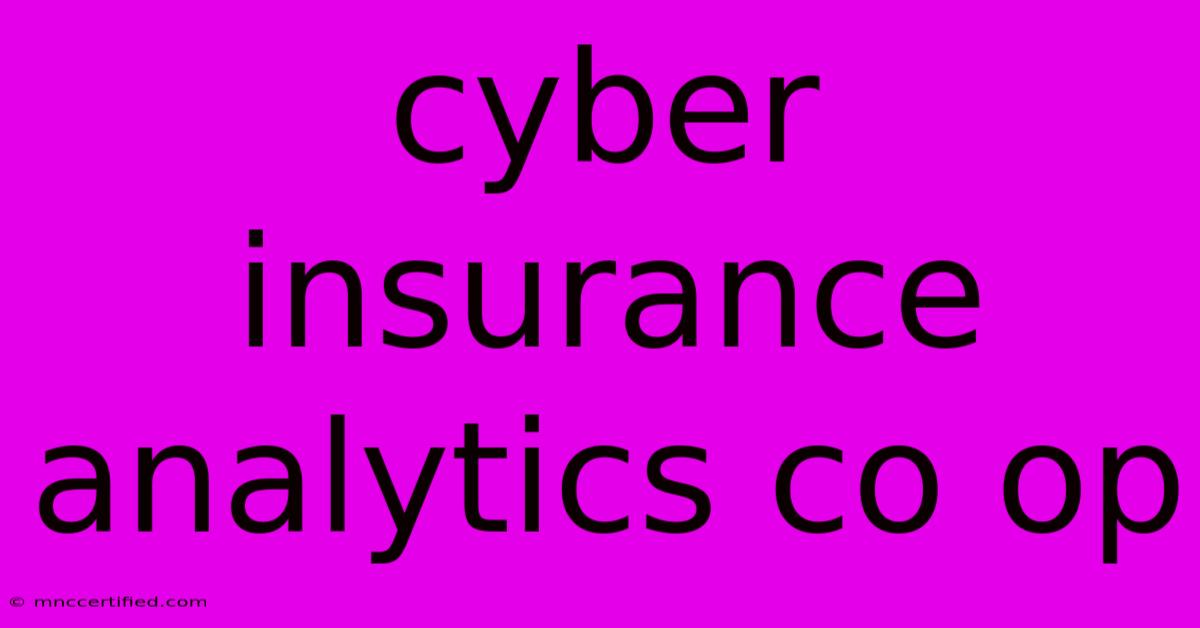Cyber Insurance Analytics Co Op

Table of Contents
Cyber Insurance Analytics Co-op: A Deep Dive into the Future of Risk Management
The cybersecurity landscape is constantly evolving, making cyber insurance increasingly crucial for businesses of all sizes. But navigating the complexities of cyber risk and insurance requires sophisticated analysis. This is where the cyber insurance analytics co-op comes into play. This article explores the vital role of these collaborative efforts in shaping the future of risk management and provides insights into how they operate and benefit both insurers and businesses.
What is a Cyber Insurance Analytics Co-op?
A cyber insurance analytics co-op is a collaborative arrangement between multiple insurance companies, often including reinsurers and potentially technology providers. These organizations pool their data and analytical expertise to gain a more comprehensive understanding of cyber threats and risk profiles. The key objective is to develop more accurate risk assessments, improve underwriting processes, and ultimately, create more effective and affordable cyber insurance products.
Unlike traditional approaches where each insurer operates in isolation, the co-op model fosters a shared knowledge base. This allows for a deeper understanding of emerging threats, vulnerabilities, and attack patterns than any single insurer could achieve independently.
Key Benefits of a Cyber Insurance Analytics Co-op:
- Enhanced Risk Assessment: By leveraging a larger dataset, co-ops can identify subtle correlations and patterns that might be missed by individual insurers. This leads to more precise risk scoring and better prediction of potential losses.
- Improved Underwriting: More accurate risk assessments result in fairer premiums and more targeted insurance products. This prevents insurers from overcharging low-risk clients or underestimating the risk for high-risk clients.
- Fraud Detection: Sharing data facilitates the detection of fraudulent claims and helps prevent insurance fraud, protecting the integrity of the cyber insurance market.
- Trend Analysis & Predictive Modeling: Co-ops can analyze historical data and current threat landscapes to identify emerging trends and develop predictive models for future cyber incidents. This informs proactive risk mitigation strategies.
- Innovation in Cyber Insurance Products: The shared insights fuel innovation, leading to the development of new and more sophisticated cyber insurance products tailored to specific industry needs and risk profiles.
- Cost Savings: While initial setup and maintenance may require investment, the long-term benefits, including reduced losses and improved efficiency, contribute to cost savings for all participating insurers.
How Does a Cyber Insurance Analytics Co-op Operate?
The specific operational structure of a cyber insurance analytics co-op can vary, but key elements typically include:
- Data Sharing Agreements: Secure and confidential data sharing agreements are crucial to protect sensitive information while facilitating collaboration. Strict adherence to data privacy regulations (like GDPR and CCPA) is paramount.
- Data Aggregation and Standardization: Data from diverse sources must be aggregated, cleaned, and standardized to ensure consistency and accuracy in analysis.
- Advanced Analytics Techniques: Sophisticated analytical tools and techniques, including machine learning and artificial intelligence, are employed to analyze the vast datasets.
- Shared Reporting and Insights: The co-op develops standardized reporting mechanisms to share key insights and findings with participating insurers.
- Governance and Oversight: A robust governance structure is essential to manage the co-op, ensure compliance with regulations, and resolve potential conflicts.
The Future of Cyber Insurance Analytics Co-ops
The future of cyber insurance is intrinsically linked to the continued growth and sophistication of analytics co-ops. As the volume and complexity of cyber threats increase, the need for collaborative approaches to risk management will only become more critical. We can anticipate:
- Increased Data Sharing: Wider participation and increased data sharing will lead to even more accurate risk models.
- Integration of Threat Intelligence: Co-ops will integrate real-time threat intelligence feeds to enhance their predictive capabilities and provide proactive warnings to policyholders.
- AI-Driven Risk Assessment: Artificial intelligence and machine learning will play an even more significant role in automating risk assessment and underwriting processes.
- Personalized Cyber Insurance: Co-ops will enable the development of highly personalized cyber insurance policies tailored to individual client needs and risk profiles.
Conclusion: A Collaborative Approach to a Complex Problem
Cyber insurance analytics co-ops represent a crucial step forward in addressing the growing challenges of cyber risk. By leveraging the power of collaboration and advanced analytics, these initiatives enhance risk assessment, improve underwriting, and ultimately, contribute to a more secure and resilient digital world. The future of cyber insurance is undoubtedly shaped by this collaborative approach. As cyber threats continue to evolve, the role of these co-ops will only become more vital in protecting businesses and individuals from the devastating impact of cyberattacks.

Thank you for visiting our website wich cover about Cyber Insurance Analytics Co Op. We hope the information provided has been useful to you. Feel free to contact us if you have any questions or need further assistance. See you next time and dont miss to bookmark.
Featured Posts
-
Attorney General Nominee Pam Bondi
Nov 23, 2024
-
Remaining Jfk Files Trumps Release
Nov 23, 2024
-
Bayern Munich Game Bundesliga Live Stream
Nov 23, 2024
-
Snagging Coldplay Tickets In Hull
Nov 23, 2024
-
South Korean 100 Won Coin Worth
Nov 23, 2024